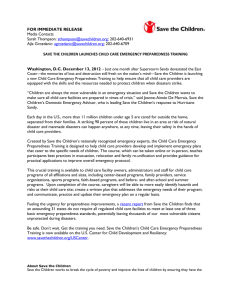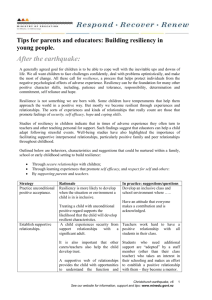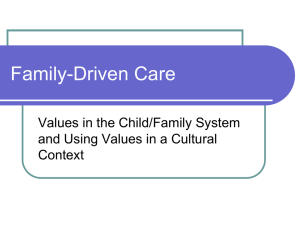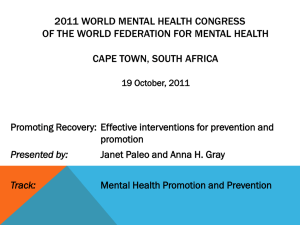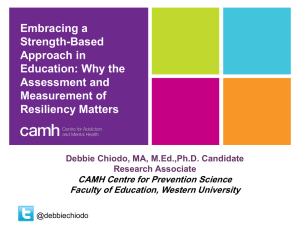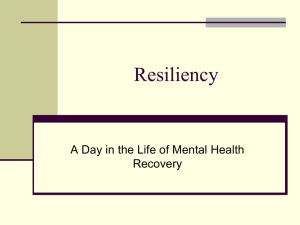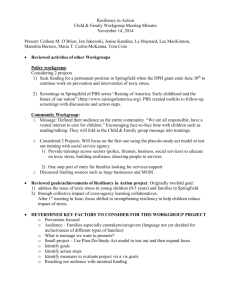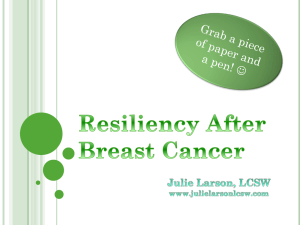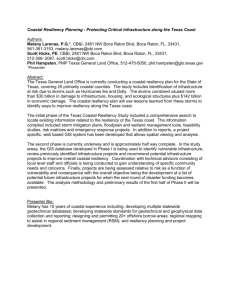510-FA14-Carnegie-20140827-165222
advertisement
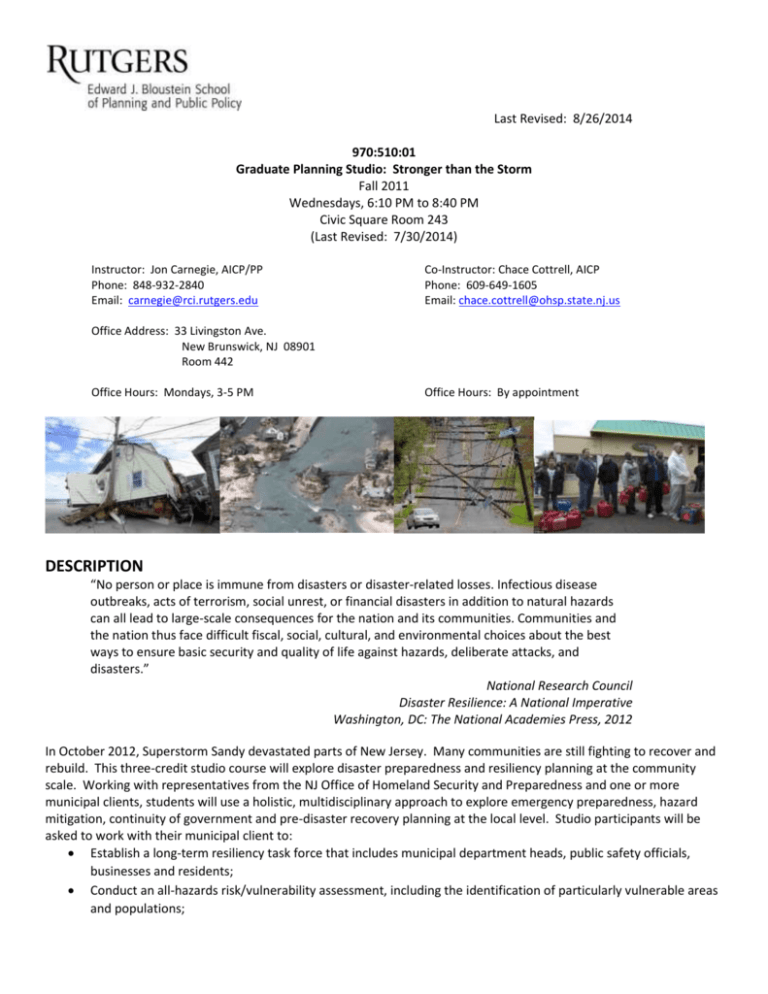
Last Revised: 8/26/2014 970:510:01 Graduate Planning Studio: Stronger than the Storm Fall 2011 Wednesdays, 6:10 PM to 8:40 PM Civic Square Room 243 (Last Revised: 7/30/2014) Instructor: Jon Carnegie, AICP/PP Phone: 848-932-2840 Email: carnegie@rci.rutgers.edu Co-Instructor: Chace Cottrell, AICP Phone: 609-649-1605 Email: chace.cottrell@ohsp.state.nj.us Office Address: 33 Livingston Ave. New Brunswick, NJ 08901 Room 442 Office Hours: Mondays, 3-5 PM Office Hours: By appointment DESCRIPTION “No person or place is immune from disasters or disaster-related losses. Infectious disease outbreaks, acts of terrorism, social unrest, or financial disasters in addition to natural hazards can all lead to large-scale consequences for the nation and its communities. Communities and the nation thus face difficult fiscal, social, cultural, and environmental choices about the best ways to ensure basic security and quality of life against hazards, deliberate attacks, and disasters.” National Research Council Disaster Resilience: A National Imperative Washington, DC: The National Academies Press, 2012 In October 2012, Superstorm Sandy devastated parts of New Jersey. Many communities are still fighting to recover and rebuild. This three-credit studio course will explore disaster preparedness and resiliency planning at the community scale. Working with representatives from the NJ Office of Homeland Security and Preparedness and one or more municipal clients, students will use a holistic, multidisciplinary approach to explore emergency preparedness, hazard mitigation, continuity of government and pre-disaster recovery planning at the local level. Studio participants will be asked to work with their municipal client to: Establish a long-term resiliency task force that includes municipal department heads, public safety officials, businesses and residents; Conduct an all-hazards risk/vulnerability assessment, including the identification of particularly vulnerable areas and populations; Last Revised: 8/26/2014 Undertake a strategic planning process to identify the community’s strengths, weaknesses, assets and constraints related to identified threats; Utilize traditional and leading-edge public engagement strategies to solicit input from stakeholders and the public; and Prepare a Strategic Community Resiliency Plan (SCRP). The purpose of the SCRP will be to increase the overall preparedness and resiliency of the client jurisdiction by identifying a locally-defined resiliency vision and goals and a prioritized list of short- and long-term actions to achieve that vision. The SCRP will allow the client jurisdiction to prioritize limited funding, leverage available assets and formulate innovative solutions to better protect the jurisdiction and its residents. STUDIO CLIENTS New Jersey Office of Homeland Security and Preparedness and the Town of Secaucus, New Jersey. CROSS-CUTTING THEMES/SKILL SETS 1. Community Characterization/Vulnerability Analysis a. Inventory of assets and resources b. Multi-hazard threat/risk assessment (coastal storm, repetitive flooding, winter storm, extended power outage, hazmat incident, terrorism, other?) 2. Strategic Preparedness, Continuity of Operations (COOP)/Continuity of Government (COG) 3. Risk management, hazard mitigation, adaptation 4. Community engagement (public and stakeholders) TEAM-BASED APPROACH BY FUNCTIONAL AREA 1. Land Use and Community Planning a. Housing b. Zoning/Code enforcement c. Business Continuity d. Economic Development 2. Infrastructure Systems a. Transportation (roads, bridges, transit, paratransit) b. Water Supply/Wastewater c. Stormwater management d. Power/Telecom 3. Health and Social Services a. Public Safety/Emergency Preparedness and Response/Citizen Preparedness b. Public Information & Communication (Pre-event preparedness, post-event recovery) c. Public health/health care/mental health services d. Senior services e. Education 4. Environment and Natural Systems a. Flood plains, wetlands, marshland, coastal resources b. Wildlife and Habitat c. Brownfields/Right to Know sites/Environmental Hazards (Mold) d. Forest, street trees, parks 2 Last Revised: 8/26/2014 REQUIREMENTS AND EXPECTATIONS This studio course will cover a range of topics related to hazard mitigation, pre-disaster recovery and community resiliency planning in coastal areas. Readings, classroom discussions and studio assignments will examine a range of issues associated with understanding resiliency from ecological, social, public health, economic, organizational, and built-environment perspectives. The format of the course will combine independent reading, classroom lectures, guest speakers, field work, as well as in-class and out-of-class activity assignments to prepare students to address the interdisciplinary, complex problems associated with multi-hazard resiliency planning and policy. Course Objectives: To understand the principles and elements of holistic/comprehensive community resiliency planning in the context of multiple natural and man-made hazards; To critically examine the challenges and opportunities local leaders, residents and the business community face when planning for resilient community design and governance; To apply the principles of resiliency in a real-world context; To develop individual student expertise in topics related to community resiliency that can increase effectiveness in the workplace after graduation. Course Requirements: Students will be expected to attend and participate in all class discussions and field work experiences. They will be expected the apply the knowledge gained from lectures and readings, along with their own knowledge and expertise to prepare four work products (see Assignments in Detail section below), a draft and final Strategic Community Resiliency Plan and to present the findings of their research and studio work to representatives from the Town of Secaucus and the Office of Homeland Security and Preparedness. Grading will be as follows: Grading Component Class participation Assignment #1 Assignment #2 Assignment #3 Assignment #4 Assignment #5 Cumulative Grade Percent of Grade 15% 5% 5% 25% 10% 40% 100% Assignments in detail: 1. Develop and execute a public and stakeholder engagement plan – Students must collaboratively develop a plan to engage stakeholders and the public in each phase of the resiliency planning process. Public and stakeholder engagement strategies may include but should not be limited to traditional engagement techniques, such as interviews, meetings, surveys, public workshops, information sessions as well as less traditional means such as social media approaches, pop-up kiosks, meetings-in-a-box and other innovative practices. The public engagement plan must also address what specific techniques will be used to engage with populations traditionally under-represented in community planning processes, such as low-income and communities of color, older adults, and school-age children. Public and stakeholder engagement activities should be documented throughout the process. The record of activities will be incorporated as an appendix to the Secaucus Strategic Community Resiliency Plan. 3 Last Revised: 8/26/2014 2. Inventory community features, assets and resources – Students must collect data and information on basic community demographics, important features, local assets and resources. This should include the creation of an image library as appropriate. To the extent feasible, these data should be geo-referenced to facilitate visualization and analysis in a GIS software environment. Once collected, the data and information should be compiled into a community profile or series of profiles that characterizes (visually and in narrative format) the community of Secaucus across each of the functional areas described above. A summary of the community characterization profile(s) will incorporated as a chapter in the Secaucus Strategic Community Resiliency Plan. Detailed profiles will be incorporated as an appendix to the plan. 3. Prepare a Community Risk/Vulnerability Assessment – Students will employ both quantitative and qualitative research methods to complete a strategic risk and vulnerability assessment process specific to Secaucus, NJ. The assessment will explore basic risk management concepts such as hazards, exposure, vulnerability and consequence in the context of both man-made and natural disasters, with an emphasis on vulnerabilities related to flooding, storm-surge and sea level rise. As part of the assessment process, students will work collaboratively to develop a multi-hazard resiliency scorecard (Assignment #3a) to guide the assessment process. Students will also utilize public and stakeholder engagement techniques to obtain input on the hazards and threats most important to the public and community stakeholders and to prepare a community resiliency vision statement and goals for the Town of Secaucus. The vision and goal statement will be used to guide both the risk/vulnerability assessment and the identification of risk management strategies that can be employed to manage risk and achieve Secaucus’s long-term resiliency vision and goals. The purpose of the assessment is to identify Secaucus’ strengths and weaknesses in the context of the identified vision, goals and threats across the functional areas identified above. The results of the community risk/vulnerability assessment will be detailed and communicated (visually and in narrative format) in an assessment report that will become an appendix to the Secaucus Strategic Community Resiliency Plan. A summary of the assessment report will be incorporated as a chapter in the plan. (Assignment #3b) 4. Identify risk management strategies – Students will research a range of potential risk management strategies that can be implemented to manage risk in the context of the threats and vulnerabilities identified as part of Assignment #3. As part of this assignment, students will work with officials and Secaucus to develop screening criteria that can be used to prioritize potential strategies. Potential screening criteria include technical feasibility, political feasibility, potential impacts (both positive and negative) and cost. A preliminary inventory of potential strategies and proposed screening criteria (Assignment #4a) will be presented and discussed in class prior to completing the prioritization process. The screening criteria and prioritization process will be used to develop recommendations to be included in the Secaucus Community Resiliency Plan. The results and final recommendations of the strategy identification, screening and prioritization process will be summarized as a chapter in the Secaucus Strategic Community Resiliency Plan. Detail regarding the strategies considered as part of the screen process will be included as an appendix to the plan. (Assignment #4b due concurrently with Assignment #5) 5. Prepare Draft and final Strategic Community Resiliency Plan and present final recommendations the client – Students will use each of the preceding work products to compile a draft Strategic Community Resiliency Plan for the Town of Secaucus. The plan will be presented to representatives from Secaucus and the Office of Homeland Security and Preparedness for review and comment. Students will revise and finalize the plan based on client comments. Once the plan is complete, students will prepare and deliver a final presentation of their studio work to representatives of Secaucus and the Office of Homeland Security and Preparedness at a public meeting in Secaucus. 4 Last Revised: 8/26/2014 Readings and Resources: Required Reading: http://www.nap.edu/catalog.php?record_id=13457 Climate Change and Adaptation: http://njadapt.rutgers.edu/resources/njcaa-reports http://climatechange.rutgers.edu/resources/state-of-the-climate-new-jersey-2013 Coastal Vulnerability Assessment and Resiliency: http://slrviewer.rutgers.edu/ http://www.njadapt.org/ http://www.prepareyourcommunitynj.org/ Sandy Recovery and Rebuilding: http://www.state.nj.us/dca/divisions/sandyrecovery/ http://www.rebuildbydesign.org/ http://stormrecovery.ny.gov/community-reconstruction-program Resiliency and Recovery Planning: http://www.njresiliency.com/ https://www.planning.org/research/postdisaster/ http://www.resilientamerica.org/our-communities-at-risk/extreme-weather-and-climate-change-are-we-prepared/ http://www.fema.gov/national-disaster-recovery-framework http://www.fairfaxcounty.gov/oem/pdrp/draft_predisaster_recovery_plan.pdf Hazard Mitigation: http://www.fema.gov/multi-hazard-mitigation-planning http://www.hudsoncountynj.org/hudson-county-hazard-mitigation-planning-hmp-page/ Other: http://www.secaucusnj.org/ http://www.njmeadowlands.gov/ OFFICE HOURS AND ADVISING Professor Carnegie will hold office hours every Monday from 3-5 PM (and by appointment) in Room 442 of the Civic Square Building located at 33 Livingston Avenue in downtown New Brunswick. I can also be reached by telephone at (848)932-2840 and email at carnegie@ejb.rutgers.edu. Feel free to contact me at any time on any matter. Professor Cottrell is available for office hours and advising by appointment. He can be reached by phone at (609)6491605 and by email at chace.cottrell@ohsp.state.nj.us. ACADEMIC INTEGRITY STATEMENT Academic integrity is essential to the success of the educational enterprise and breaches of academic integrity constitute serious offenses against the academic community. Every member of that community bears a responsibility for ensuring that the highest standards of academic integrity are upheld. Only through a genuine partnership among students, 5 Last Revised: 8/26/2014 faculty, staff, and administrators will the University be able to maintain the necessary commitment to academic integrity. The University administration is responsible for making academic integrity an institutional priority and for providing students and faculty with effective educational programs and support services to help them fully understand and address issues of academic integrity. The administration is also responsible for working with other members of the academic community to establish equitable and effective procedures to deal with violations of academic integrity. The faculty shares the responsibility for educating students about the importance and principles of academic integrity. Individual faculty members are also responsible for informing students of the particular expectations regarding academic integrity within individual courses, including permissible limits of student collaboration and, where relevant, acceptable citation format. Finally, all members of the faculty should report all violations of academic integrity they encounter. Students are responsible for understanding the principles of academic integrity fully and abiding by them in all their work at the University. Students are also encouraged to report alleged violations of academic integrity to the faculty member teaching the course in which the violation is alleged to have occurred. Complete information on Rutgers University’s Academic Integrity Policy can be found that the following URL: http://academicintegrity.rutgers.edu/integrity.shtml TENTATIVE TOPIC GUIDE AND SCHEDULE Wk Date Topics/Activity: Introduction & Course Overview – Jon Carnegie and Chace Cottrell 1 Sep 3 Overview of visioning, strategic planning and S.W.O.T analysis – Jon Carnegie Leading practices in public engagement – Guest Lecturer Miriam Salerno, VTC Public Relations Specialist 2 Sep 10 6-10 pm Field visit and Guided Tour of Secaucus (Neighborhoods/districts, infrastructure, natural features, points of interest, Sandy impacts, other highlights) Overview of Secaucus Government Structure and Sustainability Initiatives – Guest Lecturer David Drumeler, Secaucus Town Administrator (invited) The Meadowlands, Sandy Impacts and Meadowlands Governance – Guest Lecturer TBD, representative from the NJ Meadowlands Commission 3 Sep 17 **Assignment #1 Due – Public and Stakeholder Engagement Plan Team Presentations Discuss and Determine Final Engagement Plan Elements, Schedule and Responsibilities Work in Teams on Community Characterization and Profile(s) 6 Last Revised: 8/26/2014 Risk Management and Communications Basics – Guest Lecturer Michael Greenberg, Distinguished Professor and Associate Dean of the Faculty, Bloustein School of Planning and Public Policy 4 Sep 24 Emergency Management Basics, Guest Lecturer, Rodric Bowman, Deputy Chief/ Planning & Project Management, NJ Office of Homeland Security & Preparedness Planning for Continuity of Operations/Continuity of Government, Guest Lecturer, Alison Tarnopol, NJ Office of Homeland Security & Preparedness ** Assignment #2 Due – Community Characterization/Profile(s) 5 Oct 1 Team Presentations/Discussion Overview of Multi-hazard Mitigation Planning – Jon Carnegie and Chace Cottrell Climate Change, Sea Level Rise and Adaptation in New Jersey – Guest Lecturer, Marjorie Kaplan, Associate Director, Rutgers Climate Institute 6 Oct 8 Visualizing Risk - NJ Flood Mapper, NJ ADAPT and other tools and data – Guest Lecturer Jennifer Rovito-Whytlaw, Senior Research Specialist, Environmental Analysis and Communications Group, Bloustein School of Planning and Public Policy Coastal Vulnerability Assessment & Getting To Resilience tool – Lisa Auermuller, Watershed / Outreach Coordinator, Rutgers University’s Jacques Cousteau Coastal Education Center (invited) Planning for terrorist threats – Guest Lecturer TBD, NJOHSP, NJOEM or NJ TRANSIT representative 7 Oct 15 Emergency Preparedness and Hazard Mitigation Planning in Secaucus and Hudson County – Guest Lecturers Vincent Massaro, Town of Secaucus Office of Emergency Management and Jim Woods, OEM Director, Hudson County, OEM Operations Work in teams to develop/refine draft Resiliency Scorecards ** Assignment #3a Due - Draft Resiliency Scorecards 8 Oct 22 Team presentations/class discussion Identifying leading practices and case studies – Jon Carnegie and Chace Cottrell 9 Oct 29 Work in Teams on Community Risk/Vulnerability Assessment and Leading Practice Research 7 Last Revised: 8/26/2014 **Assignment #3b is Due – Community Risk/Vulnerability Assessment Team presentations/discussion with Client 10 Nov 5 ** Assignment #4a is Due – Preliminary List of Risk Management Strategies and Proposed Screening Criteria Team presentations/discussion Client 11 Nov 12 Work in teams to complete strategy screening and develop recommendations 12 Nov 26 13 Dec 3 NO CLASS ** Assignment #4B and 5 due concurrently – Draft Strategic Community Resiliency Plan and Draft Slide Deck for public presentation Team presentations/Discussion Client Review Period 14 Dec 10 15 TBD Class to be scheduled as needed based on status/progress of previous assignments, revisions needed to final plan and final presentation slide deck. Final Public Presentation (To be scheduled between Dec 15-22) 8
